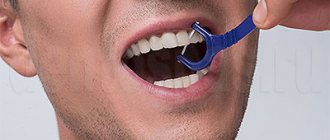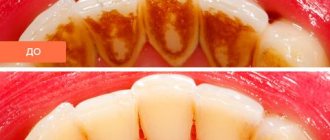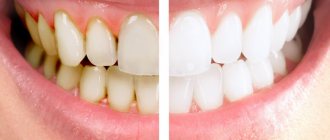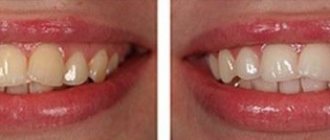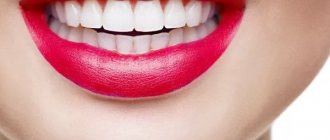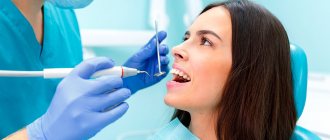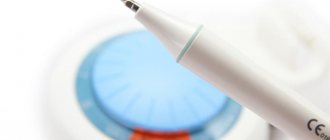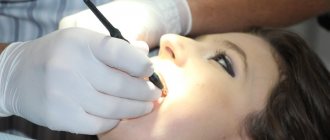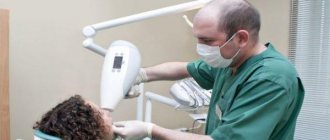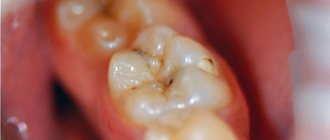Hygiene = whitening?!
So much has already been said about the importance of maintaining oral hygiene.
However, patients are still wary of this procedure. Is it really that important?! Professional cleaning is one of the most important oral care procedures! Its colossal role is in the prevention of many diseases not only of teeth, but also of gums!
How to take care of your teeth at home
Independent oral hygiene significantly prolongs the effect of professional teeth cleaning. Basic rules for maintaining healthy and beautiful teeth:
1. Choose the right toothbrush:
- with artificial bristles and rounded ends. Bacteria accumulate more quickly on natural bristles, and sharp tips damage the enamel,
- with a small head covering 2-3 teeth for more thorough cleaning,
- with a comfortable handle.
It is important to change your toothbrush every 2-3 months. Otherwise, particles of food and dental plaque accumulate on the bristles, in which bacteria multiply.
2. When choosing toothpaste, pay attention to abrasiveness.
The abrasiveness index (RDA) indicates the ability of the toothpaste to disrupt the enamel structure. For gentle toothpastes, this figure is no higher than 80 RDA. You can see it on the packaging.
3. Use dental floss to remove food debris from between teeth.
4. Brush your teeth 2 times a day for 3 minutes. Wherein:
- Vertical sweeping movements from the gums down.
- Don't press too hard on the brush.
- Clean all accessible tooth surfaces.
- After teething, clean your tongue and buccal mucosa.
Pay attention to the hygiene of your teeth and gums, and then the result of professional cleaning will please you longer.
Teeth cleaning and whitening
Many people think that after brushing their teeth will become several shades lighter, but this is not true. Cleaning and whitening are completely different procedures.
The first is aimed at removing plaque, including pigmented plaque, cleaning all surfaces of teeth, and polishing them. After this manipulation, the teeth do look lighter, but only by 1-2 shades. But whitening can dramatically change the color of your smile due to various types of effects on tooth enamel. Thus, it becomes 8 or even 10 shades lighter, and this is a very noticeable difference.
Tartar versus ultrasound
Tartar is plaque that was not removed in time and managed to mineralize to a dense state. It consists of calcium salts and a whole “cocktail” of bacteria.
Tartar has a mechanical traumatic effect on the gums, and the microorganisms contained in it are a source of chronic periodontal inflammation.
If the stone is located on the surface of the tooth, at the edge of the gum (supra-gingival), there is a fairly high risk that the infectious process will spread under the gum. This, in turn, is fraught with the formation of periodontal pockets - spaces between the gum and tooth, and the development of periodontitis. Periodontitis is difficult to treat. Over time, it leads to loss of bone tissue, exposure of tooth roots, and then to pathological mobility of teeth and their loss.
This is why timely removal of tartar is so important! After all, the only reason for the formation of stones is insufficient oral hygiene, and the consequences are extremely unpleasant:
- Smell from the mouth
- Bleeding
- Caries
- Diseases of the oral mucosa
- Tooth mobility
- Inflammation of the gums (gingivitis, periodontitis)
- Worsening of systemic diseases: rheumatoid arthritis, diabetes mellitus, cardiovascular failure, etc.
Professional teeth cleaning will include thorough removal of supra- and subgingival tartar using ultrasound. Under the influence of waves emitted by the tip of the nozzle, the attachment of deposits and the bacteria they contain to the tooth is disrupted.
NKclinic also offers deep treatment of periodontal pockets and tooth root polishing, which protects against the formation of new plaque and infection, using the Vector treatment device.
NKclinic will help you get sick less often and preserve your smile until your old age!
How is professional hygiene performed?
Carrying out professional oral hygiene occurs in several stages.
- To begin with, the patient, doctor and assistant are prepared. Then the oral cavity is cleaned of hard dental deposits - these are stones. An ultrasonic scaler helps get rid of them. This device creates vibration that easily breaks all the stones.
ATTENTION! If you have a pacemaker, the use of ultrasound machines is not recommended! This may adversely affect the performance of the heart pacemaker.
- The next step is to clean the teeth from soft plaque using the AirFlow device. It works like a sandblaster. It delivers a mixture of cleaning powder and water under pressure. Abrasive particles of this composition remove soft and pigmented plaque from the enamel. Most often, the main active ingredient is soda; it cleans teeth very effectively and is completely safe. Glycine can also be used; it is more often taken for cleaning by children and people with an increased risk of allergies.
Thus, professional hygiene methods are: ultrasonic cleaning and cleaning with an AirFlow device.
After the manipulations, the doctor examines the oral cavity and cleans the interdental spaces, if necessary. After cleaning, carious cavities and other damage to the enamel are clearly visible, so the specialist can immediately tell which teeth exactly need therapeutic treatment.
- The next step is to polish all surfaces of the teeth. This is a very important part of the procedure! On a smooth polished surface, plaque settles much more slowly. This reduces the risk of caries.
- After cleaning, the enamel is remineralized. This is the saturation of the tooth with useful minerals, which strengthen the structure of hard tissues and also reduce increased sensitivity.
A full range of professional oral cleaning includes:
- Removing all types of plaque
- Teeth polishing
- Remineralizing therapy
What are the indications for professional teeth cleaning at the dentist?
It is recommended to consult a dentist for such a procedure in the following cases:
- The need to eliminate tartar in both supragingival and subgingival locations;
- Removing hard and soft plaque;
- For the prevention of diseases of hard dental tissues (caries and non-carious lesions);
- Treatment and prevention of periodontal diseases (gingivitis, periodontitis, periodontal disease);
- Elimination of bad breath;
- Prevention of the development of periodontal bleeding;
- As the first stage of the teeth enamel whitening procedure.
The frequency of the procedure is recommended once every 6 months, but more often is possible. Modern methods of professional teeth cleaning are very gentle and do not have a negative effect on the oral cavity or to a minimal extent.
You can independently determine when you need to visit a clinic for professional cleaning by looking at the following negative signs in the oral cavity:
- Bad breath, but gastrointestinal diseases have not been diagnosed;
- There is bleeding gums, itching and burning in the mouth;
- Visual presence of tartar;
- The tooth may hurt;
- Change in periodontal color (cyanosis or hyperemia);
- There is subsidence of the gums, they may bleed;
- There is a feeling of heaviness and pain in the periodontium when chewing food, especially sour or spicy;
- There is a violation of the periodontal attachment.
It should be noted that there are practically no contraindications for professional teeth cleaning. There are only general relative limitations, such as the acute stage of inflammatory processes in the body.
The basic methods of professional teeth cleaning are based on a modern correct approach to the problem and involve a complex effect during the process of professional teeth cleaning at the dentist. At the same time, manual and hardware cleaning methods are distinguished.
Hardware methods of teeth cleaning
Professional oral cleaning is performed by periodontists or hygienists. The procedure is preventive and does not require special preparation; in extreme cases, local anesthesia is performed. Of the hardware methods, the following techniques are the most popular.
Cleaning teeth at the dentist using the air flow method
During the cleaning process using the Air Flow method, hard dental deposits are exposed to abrasive material and a powerful stream of directed air. The abrasive commonly used is sodium bicarbonate. Cleaning takes place simultaneously with the supply of a thin stream of water. For an additional refreshing effect, different flavors (mint, lemon or menthol) are added to the water.
Cleaning occurs due to soda particles, which hit the enamel at high speed, removing both soft and hard plaque. At the same time, the supplied stream of water washes away the removed deposits and stones so that they do not interfere with further exposure. Water also helps reduce the heating of tooth enamel that occurs during this manipulation.
The Air Flow technique helps not only to eliminate plaque, stones and pigmentation, but also to thoroughly polish the enamel, at the same time ensuring its partial lightening. However, it should be remembered that air flow cannot whiten tooth enamel by several tones. After manipulation, hard tissues will only acquire their original color.
Reviews about Air Flow are in most cases positive, since the main advantages of the technique include:
- Availability;
- Safety;
- Painless;
- High efficiency.
The entire effect takes no more than 30 minutes. Moreover, the air flow is selected individually for each patient. And the power directly depends on the volume of dental plaque that needs to be removed. In addition, the thickness of the enamel and the individual sensitivity of the teeth are taken into account.
Despite the positive aspects of professional teeth cleaning using the Air Flow method, there are quite significant contraindications to this method. First of all, these are diseases of the respiratory tract. These include:
- Obstructive bronchitis;
- Bronchial asthma;
- Allergy to airflow components;
- Acute periodontal and hard tissue diseases;
- Multiple caries;
- Thin layer of enamel;
- Non-carious lesions associated with increased sensitivity of enamel and its excessive fragility.
The cost of the procedure in dental offices is usually not high and is affordable for everyone. In just 3-4 thousand rubles you can get a good preventive effect using the Air Flow method, as well as additional services to strengthen the hard tissues of teeth. The effect after the procedure lasts depending on the patient’s lifestyle and the absence or presence of somatic diseases. In any case, it is advisable to visit the dentist again no later than six months later.
Cleaning for gum disease
Professional oral hygiene eliminates the main cause of inflammatory processes in the gum tissue - plaque. Thus, this procedure heals soft tissues. In the absence of stones and plaque, the gums restore their shape and function. Often, in cases of acute periodontitis or gingivitis, simple professional cleaning is sufficient to eliminate bleeding, pain and inflammation. Therefore, if you have acute or chronic gum disease, it is very important to visit your dentist regularly and maintain a good level of oral hygiene yourself.
How is the procedure performed?
Professional dental hygiene includes a number of activities:
- Conversation with a dentist, collecting anamnesis, identifying complaints.
- The specialist may invite the patient to brush his teeth under his supervision, and then perform the procedure of staining the residual plaque using indicators. This way, a person can be convinced that ordinary brushing cannot completely get rid of long-existing bacterial accumulations and is completely powerless against tartar.
Also at this stage, the specialist selects products for cleaning the oral cavity, taking into account the individual characteristics of the patient: the level of cleanliness of tooth enamel, the presence of certain pathological processes, etc.
- Directly professional cleaning of the oral cavity and removal of tartar.
- Carrying out remineralizing therapy: treating enamel with fluoride-containing preparations.
Hygienic teeth cleaning can be done mechanically or using hardware. To work manually, the dentist uses special instruments: curettes, probes, scalers, etc. With their help, the doctor carefully cleans the surface of the teeth and gingival grooves from plaque and stone.
The hardware procedure can be performed in the following ways:
- Air Flow method. A special device supplies an aerosol jet that contains water and abrasives. Thus, the teeth are polished, soft plaque is removed, and the dark tint that appears when smoking, excessive consumption of coffee and strong tea is eliminated.
- Ultrasonic devices. The advantage of such instruments is their accessibility to anatomically complex areas, for example, to the anatomical grooves of chewing surfaces.
An improved ultrasonic system for professional dental hygiene is the Vector device, which combines the directed action of a wave with the use of special suspensions. Due to the use of a liquid medium, the tooth enamel does not experience stress, so this procedure is as safe and painless as possible.
What is the difference between individual and professional oral hygiene?
Individual hygiene includes all home methods for caring for the oral cavity. This is daily brushing with a manual, electric, sonic or any other brush, using brushes, rinses, irrigator or dental floss. Daily care determines the level of oral hygiene.
Professional hygiene helps to cope with the problem of accelerated plaque formation and removes stones that cannot be removed at home. Therefore, visiting a dentist prevents the occurrence of many oral diseases.
Vector Paro device
Another progressive technology in the field of dental hygiene belongs to the German company Durr Dental. The Vector Paro ultrasound device is designed to remove dental plaque under the gum, as well as for the prevention and treatment of periodontitis. Unlike conventional scalers, the tip oscillates here not horizontally, but vertically. Due to this, the risk of damage to the root surface is reduced to zero. The device does not use ordinary distilled water, but a mineral solution, which helps reduce tooth sensitivity after ultrasonic cleaning.
Recommendations after hygiene
After professional hygiene, it is recommended to adhere to several rules:
- Quit smoking for 1-2 days. Nicotine penetrates very deeply into the enamel, thereby giving an unpleasant yellow tint to the teeth. In the first two days after cleaning, the enamel is very susceptible to various pigments, so in order to maintain excellent results, bad habits must be abandoned.
- Limit the consumption of coloring products. White diet. Eating foods such as beets, carrots, tea, and coffee can lead to excessive pigment accumulation in the first days after visiting the dentist.
- Avoid eating aggressive foods. This category includes spicy, salty, hot and cold foods. Such irritating factors can provoke manifestations of increased sensitivity of teeth.
If you follow the recommendations, the result will last longer and there will be no side effects.
Oral care after professional teeth cleaning
During the first 24 hours after professional teeth cleaning, patients are not recommended to eat foods with pronounced coloring components. It is advisable to give up strong coffee, tea and smoking. Also, during the appointment, the dentist must apply special products to prevent the formation of deposits and strengthen the enamel.
After eating, you need to brush your teeth or at least rinse your mouth with water, eat an apple or chew gum. Today there are a large number of toothpastes that actively prevent the formation of any deposits. It is advisable to have them recommended to you by your dentist.
All this will help not only avoid the formation of tartar, but also prevent many diseases of the periodontium and hard dental tissues.
How much does the procedure cost?
The price of professional hygiene starts from 10,000 rubles. for a full range of hygiene procedures for both jaws. You can be confident in the quality and safety of the materials used at Dr. Lemberg's Dental Clinic. All manipulations are performed only by qualified specialists.
Oral hygiene is the most important aspect of oral care! Taking care of the cleanliness of your teeth means taking care of their health. A good level of hygiene and regular visits to the dentist can prevent many diseases at the earliest stages. The specialists at Dr. Lemberg Dental Clinic will take care of your smile and help you maintain healthy teeth!
Free consultation on the cost of treatment in our dentistry
Leave a request and the clinic administrator will contact you within 15 minutes!
Different powder compositions can be used as abrasives when brushing teeth with Air Flow, which differ not only in the size of the abrasive granules, but even in taste! The abrasive is selected individually for each patient. So, for a person with increased tooth sensitivity, a composition with tiny granules and a soft texture is used. To clean the subgingival space, a special powder can also be used, the granules of which will act as delicately as possible.
USEFUL TO KNOW: Many patients, when coming for a professional oral hygiene procedure, are interested in whether it is possible to whiten teeth using Air Flow? The answer to this question will be as follows: after brushing with Air Flow, teeth will become whiter, but the enamel will lighten to its natural shade and no more. If radical whitening is required, it is better to resort to specialized procedures.
Note that cleaning with Air Flow is also an absolutely painless procedure that is harmless to tooth enamel. Discomfortable sensations after it are excluded, but there will be a lot of beneficial effects:
- The teeth, interdental, subgingival and supragingival spaces will be completely cleared of plaque;
- This technology works great against pigmented deposits on teeth, which are a common problem for people who often drink tea, coffee, or smoke;
- Teeth become whiter, their surface is smooth, with a beautiful natural shine;
- Bad breath disappears.
And naturally, Air Flow will be an excellent prevention of caries and other oral diseases.
After high-quality and thorough cleaning of dental surfaces, professional oral hygiene continues with polishing and fluoridation of teeth. They also use professional tools and materials, and below we will tell you in detail what actions the doctor will perform and why.
Contraindications
Despite the obvious benefits, the procedure is contraindicated in the following cases:
- stomatitis – ulceration of the mucous membranes;
- infections in the acute stage;
- herpetic rashes on the lips and gums
The procedure is not recommended if you are allergic to the drugs used during cleaning.
Otherwise, hardware care will do more harm than good. We recommend visiting a doctor for consultation and determination of indications. You can make an appointment online on the website.
Air-abrasive technique AirFlow
When cleaning the oral cavity and teeth using this method, the main instrument is used - a device that supplies a water-air stream. The latter is quite powerful and contains small abrasive particles. In addition to abrasive, this jet also contains water and air. All this together removes pigmented, soft plaque. Also, the AirFlow technique can cleanse periodontal pockets of plaque.
This technology of oral and dental hygiene is considered one of the most modern. It does not cause any discomfort, does not injure the enamel, and also has minimal contraindications.
Ultraviolet teeth whitening
At the Ilatan dental clinic, you also have the opportunity to replace the ultrasound procedure with an ultraviolet one. The big advantage of the latter is that it does not cause any discomfort, is safe and easy. The disadvantage is that it is not available to everyone, because it is quite expensive, but high quality and reliability are guaranteed.
Teeth whiteness can be maintained with proper care for up to five years, that is, it is enough to replace the ultrasonic procedure with an ultraviolet one every few years and your teeth will be in perfect condition. Professional whitening is carried out using the Zoom 3 system, which makes the procedure completely safe and even enjoyable. It involves applying a special gel to the surface of the teeth, which, under the influence of ultraviolet radiation, begins to act and discolor the teeth. It is completely safe for the gums and oral mucosa.
It is worth remembering that even snow-white teeth are susceptible to the formation of plaque and tartar, which means that procedures should not be completely ruled out. Cleaning the surface of teeth with ultraviolet light is professional teeth whitening.
The price is, of course, high, but the Ilatan dental clinic offers a variety of discounts and much more. A huge advantage of ultraviolet cleaning is that it greatly brightens teeth in a short period of time and has no contraindications. But you should only go to a qualified specialist for such a procedure, so a dental clinic is an ideal option.
